Important Message
This Website Terms and Condition of Use Agreement
also known as a 'terms of service agreement'
Will be at the bottom of most web pages!
Please read it before using this website.
Thank You
|
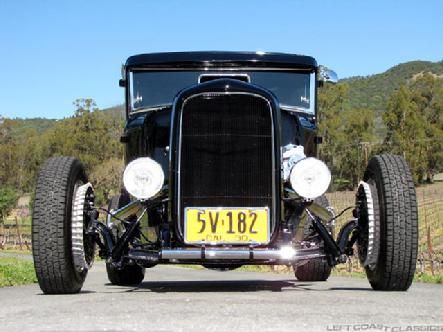 |
| 1930 Ford Model A 5-Window Coupe. |
|
|
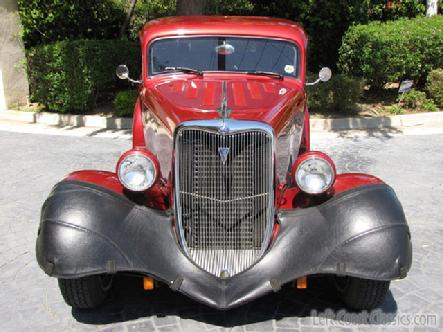 |
| 1934 Ford Tudor Hot Rod |
|
|
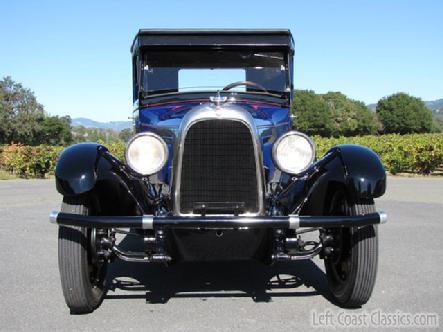 |
| 1928 Overland Whippet Window Coupe |
|
|
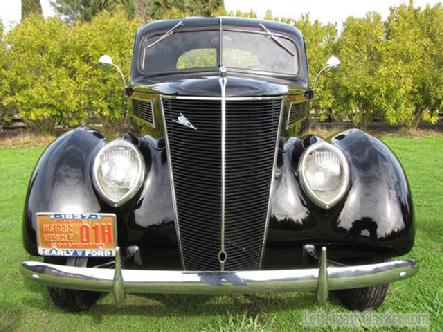 |
| 1937 Ford Coupe |
|
|
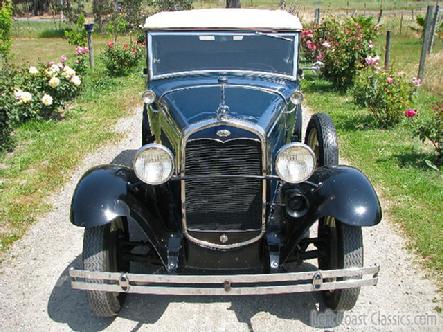 |
| 1931 Ford Model A400 Convertible |
|
|
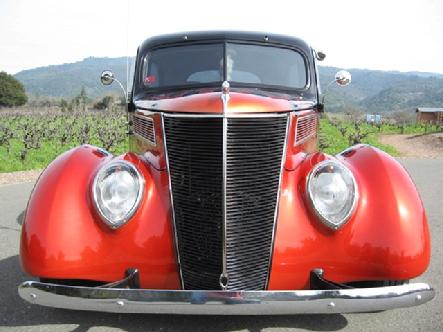 |
| 1937 Ford Tudor |
|
|
Hot rods are typically old, classic American cars with large engines modified for linear speed. The origin of the term "hot rod" is unclear. Roadsters were the cars of choice because they were light, were easy to modify, and could be bought for a low price. The term became commonplace in the 1930s or 1940s as the name of a car that had been "hopped up" by modifying the engine in various ways to achieve higher performance. A term that was common in the early days to refer to a hot rod was a "gow job". This has fallen into total disuse except with historians.
The term can also apply to other items that are "souped up" for a particular purpose, such as "hot-rodded amplifier".
|
Late 1930s–1950s
The term seems first to have appeared in the late 1930s in southern California, where people would race their modified cars on the vast, empty dry lake beds northeast of Los Angeles under the rules of the Southern California Timing Association (SCTA). The activity increased in popularity after World War II, particularly in California because many returning soldiers had been given technical training in the service. Many were prepared by Bootleggers in response to Prohibition to enable them to avoid revenue agents ("Revenooers"); some police vehicles were also modified in response.
The first hot rods were old cars (most often Fords, typically Model Ts, 1928–31 Model As, or 1932-34 Model Bs), modified to reduce weight. Typical modifications were removal of convertible tops, hoods, bumpers, windshields, and/or fenders; channeling the body; and modifying the engine by tuning and/or replacing with a more powerful type. Speedster was a common name for the modified car. Wheels and tires were changed for improved traction and handling. "Hot rod" was sometimes a term used in the 1950s as a derogatory term for any car that did not fit into the mainstream. Hot rodders' modifications were considered to improve the appearance as well, leading to show cars in the 1960s replicating these same modifications along with a distinctive paint job.
Engine swaps often involved fitting the Ford flathead engine, or "flatty", in a different chassis; the "60 horse" in a Jeep was a popular choice in the '40s. After the appearance of the 255 cu in (4.2 l) V8, because of interchangeability, installing the longer-stroke Mercury crank in the 239 was a popular upgrade among hot rodders, much as the 400 cu in (6.6 l) crank in small-blocks would become. In fact, in the 1950s, the flathead block was often fitted with crankshafts of up to 4.125 in (104.8 mm) stroke, sometimes more. In addition, rodders in the 1950s routinely bored them out by 0.1875 in (4.76 mm) (to 3.375 in (85.7 mm)); due to the tendency of blocks to crack as a result of overheating, a perennial problem, this is no longer recommended. In the '50s and '60s, the flatty was supplanted by the early hemi. By the 1970s, the small-block Chevy was the most common option, and since the '80s, the 350 cu in (5.7 l) Chevy has been almost ubiquitous.
Post WWII origins of organized rodding
After World War II there were many small military airports throughout the country that were either abandoned or very rarely used that allowed hot rodders across the country to race on marked courses. Originally drag racing had tracks as long as one mile (1.6 km) or more, and included up to four lanes of racing at the same time. As hot rodding became more popular in the 1950s, magazines and associations catering to hot rodders were started. As some hot rodders also raced on the street, a need arose for an organization to promote safety. Hot rodders including Wally Parks created the National Hot Rod Association (NHRA) to bring racing off the streets and onto the tracks. They created rules based on safety and entertainment, and allowed Hot Rodders of any caliber the ability to race. The annual California Hot Rod Reunion and National Hot Rod Reunion are held to honor pioneers in the sport. The Wally Parks NHRA Motorsports Museum houses the roots of hot rodding.
1960s rise of the street rod
As automobiles offered by the major automakers began increasing performance, the lure of Hot Rods began to wane. It was no longer necessary to put a Cadillac engine in a Ford roadster to be fast. It was now possible to buy a muscle car that outperformed just about any hot rod, with more passenger room, and without having to expend the effort of building and tuning the car oneself. After the 1973 Oil Crisis, the public called on automakers to offer safety and fuel efficiency over performance. The resulting decrease in an average car's performance led to a resurgence of Hot Rodding, although the focus was on driving Hot Rods over racing so the term 'Street Rod' was coined to denote a vehicle manufactured prior to 1949, often with a more reliable late model drivetrain. Street Rodding as it was now known was a different phenomenon than Hot Rodding, as Street Rodding was mainly family oriented. National events were hosted by the National Street Rod Association (NSRA), which also stressed safety as the NHRA did 20 years before, but this was safety for the street as opposed to on the race track. Each NSRA event has a 'Safety Inspection Team' that performs a 23 points inspection process that goes beyond what normal State Safety Inspections Require.
In the mid-1980s, as stock engine sizes fell, rodders discovered the all-aluminum 215 (Buick or Olds) could be stretched to as much as 305 cu in (5 l), using the Buick 300 crank, new cylinder sleeves, and an assortment of non-GM parts, including VW & Mopar lifters and Carter carb. It could also be fitted with high-compression cylinder heads from the Morgan +8. Using the 5 liter Rover block and crank, a maximum displacement of 317.8 cu in (5,208 cc) is theoretically possible.
Modern rodding
There is still a vibrant hot rod culture worldwide, especially in Canada, the United States, the United Kingdom, Australia and Sweden. The hot rod community has now been subdivided into two main groups: street rodders and hot rodders. Hot rodders build their cars using a lot of original equipment parts, whether from wrecking yards or NOS , and follow the styles that were popular from the 1940s through the 1960s. Street rodders build cars (or have them built for them) using primarily new parts.
|
How a "Little Deuce Coupe"
Became one of the Most Famous
Hotrods in History.
|
When it appeared on the cover of the Beach Boys popular album "Little Deuce Coupe" in 1963, Clarence "Chili" Catallo's beautiful '32 coupe hot rod...then nicknamed the "Silver Sapphire"...became an instant star.
To millions of people it was the very definition of the American Hot Rod, and shortly thereafter Chili's car became known by a new name...the "Little Deuce Coupe."
The car that became the model for the Beach Boys' song has been completely restored to its original condition and is comfortably retired in Michigan.
|
|
Here's the story...
The car was bought in 1955 by Clarence Catallo, who was just 15 years old and didn't have a driver's license. The little coupe was bought at a gas station across the street from his parent's grocery story in Allen Park, Michigan for $75.00.
A friend drove the car home for him, and the transformation into a custom began immediately.
Catallo replaced the original stock Ford engine (unlike The Beach Boys song lyrics, which mention "a flathead mill") with a newer 344-cid Olds V-8 built and installed by Bill Wanderer. He then added Olds parts to the driveline, including a Hydra-Matic transmission and a chromed 1955 rear end.
The "A Brothers" go to work on the Coupe...
Much of the original customizing work, including the stacked headlights, side trim, and front grille was done by an auto shop owned by Mike and Larry Alexander in the Detroit suburb of Southfield.
The "A Brothers" sectioned and channeled the body, added a quad-headlight fiberglass nose, made a special rolled rear pan, altered the frame, and covered the cobbled frame rails with polished aluminum fins. When the blue-lacquer paint was added Chili called the hot rod the Silver Sapphire.
On to California and the Famed Barris Custom Shop.
When Catallo was 18 he moved to Southern California and took a job sweeping floors at George Barris' Kustom shop in Lynwood, California.
This is the shop where the famed "Ala Kart" was built. It was the first custom-built pickup to combine both hot rod and custom elements, and was named "America's Most Beautiful Roadster" in 1958 and again in 1959. Chili knew he was in the right hands.
Catallo traded his labor to have the crew there tear down the hot rod, chop the top and repaint it. By 1961 the car was an all out show rod.
Hot Rod Magazine spots the Coupe!
By campaigning the coupe on the West Coast show circuit, Chili caught the attention of Hot Rod Magazine, and the car appeared on the July 1961 cover.
Its greatest fame, however, came in 1963, when it appeared on the cover of the Beach Boys' album "Little Deuce Coupe."
Chili sold the car in 1965 and the car went through some major changes over the next several years. When Chili's son, Curt, saw it at a Detroit custom car show in 1997, he convinced Chili to buy the car back.
The '32 Coupe would be the first and Last Car Chile would own...
Chili and Curt began restoring the coupe to the way it looked in the Hot Rod shoot that was used for the Beach Boys album cover.
Unfortunately, Chili passed away before the Hot Rod was returned to its glory days. Curt continued enlisting the help of many of the men who originally worked on the car, as well as General Motors.
Recognizing the blown Olds engine was a significant part of the company's history, GM helped Curt with the engine and drivetrain rebuild. The restored car appeared at the 50th Detroit Autorama in 2002.
In an interview in 2009 Curt said "The coupe was the first and last car my dad purchased."
After many changes the "Little Deuce Coupe" now looks like it did when The Beach Boys made it one of the most famous cars in Hot Rod history.
|
Click on the following phots and see the "Little Deuce Coupe" come alive once again...
|
|
A Trip Down Memory Lane!
With the Johnson's
|
 |
| Previous Page |
|
|
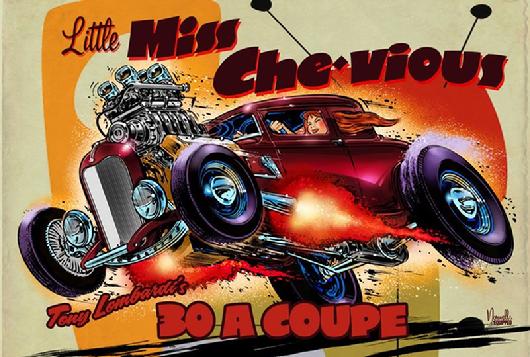 |
| Thanks for stopping by today! |
|
|
 |
| Next Page |
|
|
This website contains, in various sections, portions of copyrighted material not specifically authorized by the copyright owner. This material is used for educational purposes only and presented to provide understanding or give information for issues concerning the public as a whole. In accordance with U.S. Copyright Law Title 17 U.S.C. Section 107, the material on this site is distributed without profit. More Information
Information presented based on medical, news, government, and/or other web based articles or documents does not represent any medical recommendation or legal advice from myself or West Saint Paul Antiques. For specific information and advice on any condition or issue, you must consult a professional health care provider or legal advisor for direction.
I and West Saint Paul Antiques can not be responsible for information others may post on an external website linked here ~ or for websites which link to West Saint Paul Antiques. I would ask, however, that should you see something which you question or which seems incorrect or inappropriate, that you notify me immediately at floyd@weststpaulantiques.com Also, I would very much appreciate being notified if you find links which do not work or other problems with the website itself. Thank You!
Please know that there is no copyright infringement intended with any part of this website ~ should you find something that belongs to you and proper credit has not been given (or if you simply wish for me to remove it),
just let me know and I will do so right away.
|
Website Terms and Condition of Use Agreement
also known as a 'terms of service agreement'
By using this website, West Saint Paul Antiques . Com, you are agreeing to use the site according to and in agreement with the above and following terms of use without limitation or qualification. If you do not agree, then you must refain from using the site.
The 'Terms of Use' govern your access to and use of this website and facebook pages associated with it. If you do not agree to all of the Terms of Use, do not access or use the website, or the facebook sites. By accessing or using any of them, you and any entity you are authorized to represent signify your agreement to be bound by the Terms of Use.
Said Terms of Use may be revised and/or updated at any time by posting of the changes on this page of the website. Your continued usage of the website, or the facebook site(s) after any changes to the Terms of Use will mean that you have accepted the changes. Also, any these sites themselves may be changed, supplemented, deleted, and/or updated at my sole discretion without notice; this establishes intellectual property rights by owner (myself).
It saddens me to include a Terms of Use for West Saint Paul Antiques . Com, but we all realize it is something that is necessary and must be done these days. By using the website, or facebook for West Saint Paul Antiques, you represent that you are of legal age and that you agree to be bound by the Terms of Use and any subsequent modifications. Your use of the West Saint Paul Antiques sites signify your electronic acceptance of the Terms of Use and constitute your signature to same as if you had actually signed an agreement embodying the terms.
|
|